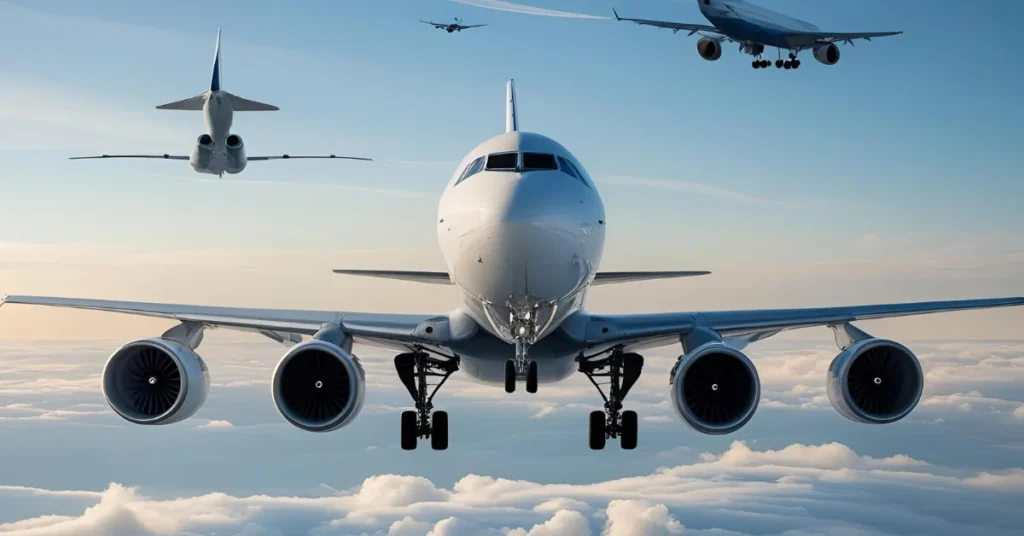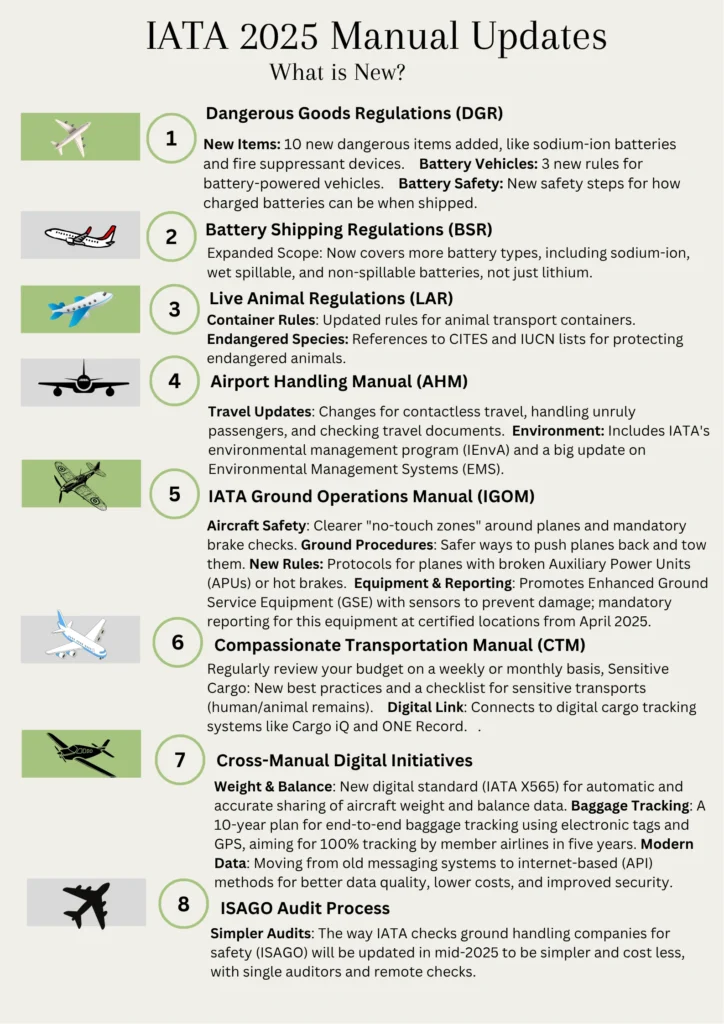Overview
IATA’s 2025 Aviation Manual Updates: The International Air Transport Association (IATA) has released updated versions of its important rulebooks for 2025. These rulebooks are like instruction manuals that help make sure everything runs smoothly and safely at airports and during flights. The information for this analysis comes from IATA’s official announcements and various industry news reports.
These updates are not just small tweaks; they include over 350 changes across several key manuals Such as:
- The Ground Operations Manual (IGOM)
- The Dangerous Goods Regulations (DGR)
- Battery Shipping Regulations (BSR)
- Live Animal Regulations (LAR)
- Airport Handling Manual (AHM),and
- The Compassionate Transportation Manual (CTM)
The extensive number of changes and their broad reach across many different manuals show that IATA is making a big, planned effort to modernize and adapt the way air transport works. It’s not just about fixing one small thing; it’s about making the whole system better.
These changes are a strategic response to new technologies, changing customer needs, and the industry’s focus on becoming more digital, environmentally friendly, and safe.
This means IATA is actively working to make the aviation industry more connected, driven by information, and ready for the future.
The updates are guided by four main goals:
- Making things safer
- Making rules the same everywhere (standardization)
- Making baggage handling better
- Making aviation more Earth-friendly and welcoming for everyone (sustainability and inclusivity).
Key Highlights of IATA’s 2025 Aviation Manual Updates
The 2025 IATA manual updates introduce important changes aimed at improving various aspects of aviation operations.
A major focus is on Safer Operations, with new rules for handling aircraft on the ground, such as clearer “no-touch zones” and mandatory brake checks.
These rules are based on real data to help prevent accidents. This emphasis on using data and advanced equipment with sensors, known as Enhanced Ground Service Equipment (GSE), shows a significant shift.
It means IATA is moving away from just reacting to accidents and instead focusing on preventing them before they happen, using technology to reduce human errors and risks on the ground.
Another highlight is the push for Smarter Technology, including digital ways to share important information like aircraft weight, making operations more accurate and safer.
There’s also a Better Baggage Handling plan, a 10-year roadmap to use technology for tracking bags from start to finish, aiming to reduce lost luggage and make travel smoother.
Furthermore, the updates promote Greener and Fairer Travel through guidance for using electric ground equipment to cut down on pollution and efforts to make air travel easier for people with special needs.
Finally, by promoting Global Rules, IATA aims to help all parts of the aviation industry work together more easily and safely.
Issued By
International Air Transport Association (IATA).

Document Ref
The information presented in this report is compiled from IATA’s official press releases and various industry news articles regarding the 2025 manual updates. These sources include:
- IATA Pressroom releases
- IATA Publications Manuals pages
- Industry news outlets reporting on IATA’s updates
What’s New in IATA’s 2025 Aviation Manual Updates
IATA has updated many of its important rulebooks for 2025, with over 350 changes in total. These updates are like new instructions to make sure everything in air travel is safe, smooth, and modern.
The consistent use of digital tools and data across these various manuals, such as for weight and balance, baggage tracking, and information sharing, points to a fundamental industry shift.
This indicates a move towards smart, connected operations, which will lead to big improvements in how efficient, accurate, and safe air travel is by reducing manual work and making sure information flows quickly.
This also means that aviation ground operations will rely more and more on computer systems and cybersecurity.
Here’s a summary of the key changes across different manuals:
Key IATA Manual Updates for 2025

| Manual Name | Key Changes |
|---|---|
| Dangerous Goods Regulations (DGR) | Includes 10 new dangerous items (e.g., sodium-ion batteries, fire suppressant devices). Adds 3 new rules for battery-powered vehicles. Introduces new safety steps for how charged batteries can be when shipped. |
| Battery Shipping Regulations (BSR) | Expanded to cover more battery types beyond just lithium, such as sodium-ion batteries and different wet or non-spillable batteries. |
| Live Animal Regulations (LAR) | Updates rules for animal transport containers. Includes references to lists of endangered animals (CITES and IUCN) to help protect them. |
| Airport Handling Manual (AHM) | Updates for contactless travel, handling unruly passengers, and checking travel documents. Includes information about IATA’s environmental management program (IEnvA) and a big revision on Environmental Management Systems (EMS). |
| IATA Ground Operations Manual (IGOM) | Clearer “no-touch zones” around aircraft. Mandatory brake checks and use of guide personnel. Safer ways to push planes back from the gate and tow them. New rules for planes with broken Auxiliary Power Units (APUs) or hot brakes. Better guidance for fire safety and where to place wheel chocks. Promotes Enhanced Ground Service Equipment (GSE) with sensors to prevent aircraft damage; mandatory reporting for this equipment at certified locations from April 2025. |
| Compassionate Transportation Manual (CTM) | New best practices and a checklist for sensitive transports (human/animal remains). Connects to digital cargo tracking systems like Cargo iQ and ONE Record. |
| Cross-Manual Digital Initiatives | New digital standard (IATA X565) for automatic and accurate sharing of aircraft weight and balance data. A 10-year plan for end-to-end baggage tracking using electronic tags and GPS, aiming for 100% tracking by member airlines in five years. Modernizing information sharing from old messaging systems to internet-based (API) methods for better quality, lower costs, and improved security. |
| ISAGO Audit Process | The way IATA checks ground handling companies for safety (ISAGO) will be updated in mid-2025 to be simpler and cost less, with single auditors and remote checks. |
Who Is Affected from IATA’s 2025 Aviation Manual Updates
These updates affect almost everyone invIATA’s 2025 Aviation Manual Updatesolved in air travel and cargo shipping. The wide reach of these changes across all parts of the aviation industry highlights how connected everything is.
For these new rules to work well, everyone involved needs to work together and adopt them at the same time.
This means that ongoing training, new investments, and clear communication across the entire industry are very important to make sure the new standards are applied consistently for the best safety and efficiency.
The main groups affected include:
- Airlines: The companies that fly airplanes.
- Airports: The places where planes take off and land.
- Ground Service Providers (GSPs): Companies that handle planes and bags on the ground at airports.
- Freight Forwarders: Companies that arrange for goods to be shipped around the world.
- Shippers: People or companies sending goods, especially dangerous items or live animals.
- Manufacturers: Companies that make airplanes, ground equipment, or even the dangerous goods being shipped.
- Passengers: Travelers will experience smoother baggage handling and safer operations overall.
- Regulators: Bodies like ICAO (International Civil Aviation Organization) whose standards are often included in IATA manuals.
Editor’s Insight
The 2025 IATA manual updates are much more than just minor rule changes; they represent a big step forward for the entire aviation industry.
The main message is clear: safety, efficiency, and sustainability are being built into every part of air travel through smart use of data and technology.
One of the biggest changes is how IATA is using real-world information from programs like IDX and ADX to make safety rules.
Instead of just reacting to problems after they happen, they are using this information to predict and prevent issues.
This is like using a map to avoid bumps in the road before you even get there. For example, the new “no-touch zones” and rules for ground equipment are direct results of this data-driven approach.
These updates also push for everyone to follow the same rules, no matter where they are in the world. This is super important because it makes training easier, reduces mistakes, and helps different companies work together smoothly.
Think of it like everyone speaking the same language – it makes communication much better. The updated ISAGO audits and the IATA Ground Operations Manual (IGOM) help make this happen.
The strong focus on tracking baggage digitally is a game-changer for passengers. Lost bags are a big headache, and by using technology to follow bags every step of the way, IATA aims to make travel much less stressful and more reliable for everyone. This also shows a strong focus on improving the passenger’s experience.
The push for electric ground equipment and better handling of mobility aids shows aviation’s commitment to being more environmentally friendly and welcoming to all travelers. These changes are not just about rules; they are about making air travel better for our planet and for people with diverse needs.
The emphasis on digitalization and sustainability alongside traditional safety and standardization shows that IATA is strategically preparing the aviation industry for the future. This indicates a long-term vision where excellent operations go hand-in-hand with being responsible towards the environment and accessible to everyone, getting the industry ready for future rules, customer demands, and new technologies.
This suggests that future updates will likely continue this trend, making “green” and “inclusive” operations standard practice rather than optional additions.
Ultimately, the success of these updates depends on everyone involved – airlines, airports, ground handlers, and even equipment makers – working together. It’s a shared responsibility to make sure these new, smarter ways of working are put into practice everywhere.
Official Source
International Air Transport Association (IATA) official website: www.iata.org IATA Pressroom for official announcements and detailed reports on manual updates.



